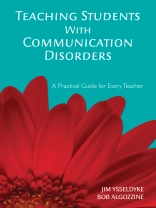Strengthen the spoken and written expression of students with speech and language disorders!
Communication disorders affecting speech and language rank as the second most common reason students receive special education. How can special and general education teachers help these students achieve successful outcomes academically and in their interpersonal relationships? What instructional approaches provide the most beneficial learning experiences, and help build confidence and self-esteem?
Teaching Students With Communication Disorders offers tools to help educators identify communication disorders, distinguish speech from language impairments, reduce common communication problems, and eliminate negative stereotypes. Providing a pretest, posttest, key vocabulary terms, and additional resources to help teachers and speech therapists increase their understanding about communication disorders and effective intervention strategies, this valuable resource highlights:
- Criteria for identifying speech and language disorders
- Cognitive, academic, physical, behavioral, and communication characteristics of common communication disorders
- Appropriate teaching and class management strategies
- Trends and issues influencing instructional approaches and the delivery of speech and language services
Mục lục
About A Practical Approach to Special Education for Every Teacher
Acknowledgements
About the Authors
Self-Assessment I
Introduction to Teaching Students With Communication Disorders
1. What Are Communication Disorders?
Speech Disorders
Language Disorders
Criteria for Identification
2. What Characteristics Are Associated With Communication Disorders?
Cognitive
Academic
Physical
Behavioral
Communication
3. How Do Teachers Teach Students With Communication Disorders?
Reducing Speech Problems
Reducing Language Problems
Reducing Interpersonal Problems
4. What Trends and Issues Influence how We Teach Students With Communication Disorders?
5. Communication Disorders in Perspective
Team Approach to Providing Services
Pulling Students Out of the Classroom
Combating Negative Stereotypes
Tips to Improve Communication
6. What Have We Learned?
Key Points
Key Vocabulary
Self-Assessment II
Answer Key for Self-Assessments
On Your Own
Resources
Books
Journals & Articles
Organizations
References
Index
Giới thiệu về tác giả
Bob Algozzine is a professor in the Department of Educational Leadership at the University of North Carolina and project codirector of the U.S. Department of Education-supported Behavior and Reading Improvement Center. With 25 years of research experience and extensive firsthand knowledge of teaching students classified as seriously emotionally disturbed, Algozzine is a uniquely qualified staff developer, conference speaker, and teacher of behavior management and effective teaching courses. He is active in special education practice as a partner and collaborator with professionals in the Charlotte-Mecklenburg schools in North Carolina and as an editor of several journals focused on special education. Algozzine has written more than 250 manuscripts on special education topics, including many books and textbooks on how to manage emotional and social behavior problems.












